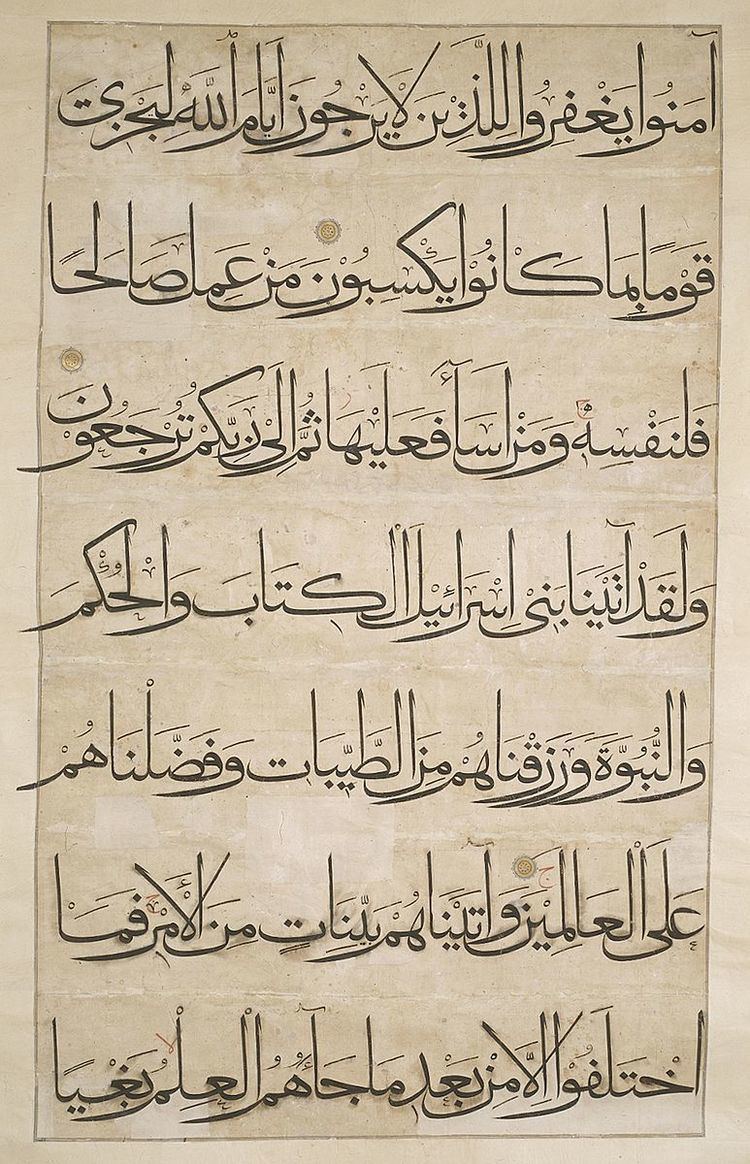Glottolog None | ||
 | ||
Era 7th century AD to 9th century AD Early forms Old ArabicClassical Arabic | ||
Classical Arabic is the form of the Arabic language used in Umayyad and Abbasid literary texts from the 7th century AD to the 9th century AD.
Contents
The orthography of the Qurʾān was not developed for the standardized form of Classical Arabic; rather, it shows the attempt on the part of writers to utilize a traditional writing system for recording a non-standardized form of Classical Arabic.
Modern Standard Arabic (MSA) is its direct descendant used today throughout the Arab world in writing and in formal speaking, for example, prepared speeches, some radio broadcasts, and non-entertainment content. While the lexis and stylistics of Modern Standard Arabic are different from Classical Arabic, the morphology and syntax have remained basically unchanged (though MSA uses a subset of the syntactic structures available in CA). In the Arab world, little distinction is made between CA and MSA, and both are normally called al-fuṣḥá (الفصحى) in Arabic, meaning 'the most eloquent (Arabic language)'.
History
In the late 6th century AD, a relatively uniform intertribal ‘poetic koine’ distinct from the spoken vernaculars developed based on the Bedouin dialects of Najd, probably in connection with the Lakhmid court of al-Ḥīra. During the first Islamic century the majority of Arabic poets and Arabic-writing persons spoke a form of Arabic as their mother tongue. Their texts, although mainly preserved in far later manuscripts, contain traces of non-standardized Classical Arabic elements in morphology and syntax. The standardization of Classical Arabic reached completion around the end of the 8th century. The first comprehensive description of the ʿarabiyya "Arabic", Sībawayhi's al-Kitāb, is based first of all upon a corpus of poetic texts, in addition to the Qurʾān and Bedouin informants whom he considered to be reliable speakers of the ʿarabiyya. By the 8th century, knowledge of Classical Arabic had become an essential prerequisite for rising into the higher classes throughout the Islamic world.
Consonants
Ibn Khaldun described the pronunciation of the ⟨ق⟩ as a voiced velar /g/ and that it might have been the old Arabic pronunciation of the letter. He even described that the Islamic prophet Muhammad may have had the /g/ pronunciation.
Vowels
^1 Allophone of short [a] in certain imalah contexts^2 In pre-Classical Arabic, [eː] arose out of contraction of certain Old Arabic triphthongs. Some Arabs said banē < *banaya and zēda < *zayida for banā ("he built") and zāda ("it increased"). This [eː] merged with [aː] in later Classical Arabic. A completely different phenomenon called imalah led to the raising of [a(ː)] adjacent to a sequence i(ː)C or Ci(ː), where C was a non-emphatic, non-uvular consonant, e.g. al-kēfirīna < al-kāfirīna ("the disbelievers")^3 Allophone of [a(ː)] after uvular and emphatic consonantsCase
The A1 inscription dated to the 3rd or 4th c. AD in Greek script in a dialect showing affinities to that of the Safaitic inscriptions shows that short final high vowels had been lost in at least some dialects of Old Arabic at that time, obliterating the distinction between nominative and genitive case in the singular, leaving the accusative the only marked case:
أوس (بن) عود (بن) بناء (بن) كازم ٱلإدامي أتو من شحاص؛ أتو بناء ٱلدورة ويرعو بقلة بكانون.
ʾAws (bin) ʿūḏ (?) (bin) Bannāʾ (bin) Kazim ʾal-ʾidāmiyy ʾatawa miś-śiḥāṣ; ʾatawa Bannāʾa ʾad-dawra wa yirʿaw baqla bi-kānūn
"ʾAws son of ʿūḏ (?) son of Bannāʾ son of Kazim the ʾidāmite came because of scarcity; he came to Bannāʾ in this region and they pastured on fresh herbage during Kānūn".
Classical Arabic however, shows a far more archaic system, essentially identical with that of Proto-Arabic:
State
The definite article spread areally among the Central Semitic languages and it would seem that Proto-Arabic lacked any overt marking of definiteness. Besides dialects with no definite article, the Safaitic inscriptions exhibit about four different article forms, ordered by frequency: h-, ʾ-, ʾl-, and hn-. The Old Arabic of the Nabataean inscriptions exhibits almost exclusively the form ʾl-. Unlike the Classical Arabic article, the Old Arabic ʾl almost never exhibits the assimilation of the coda to the coronals; the same situation is attested in the Graeco-Arabica, but in A1 the coda assimilates to the following d, αδαυρα */ʾad-dawra/ ٱلدورة 'the region'.
In Classical Arabic, the definite article takes the form /ʾal-/, with the coda of the article exhibiting assimilation to the following dental and denti-alveolar consonants. Note the inclusion of palatal [ɕ], which alone among the palatal consonants exhibits assimilation, indicating that assimilation ceased to be productive before that consonant shifted from Old Arabic [ɬ]:
Barth-Ginsberg alternation
Proto-Central Semitic, Proto-Arabic, various forms of Old Arabic, and some modern Najdi dialects to this day have alternation in the performative vowel of the prefix conjugation, depending on the stem vowel of the verb. Early forms of Classical Arabic allowed this alternation, but later forms of Classical Arabic levelled the /a/ allomorph:
